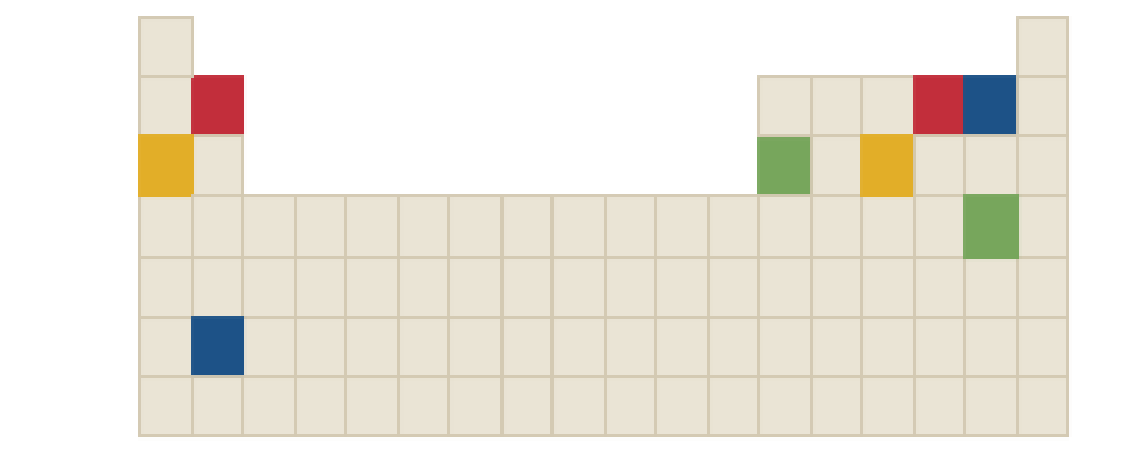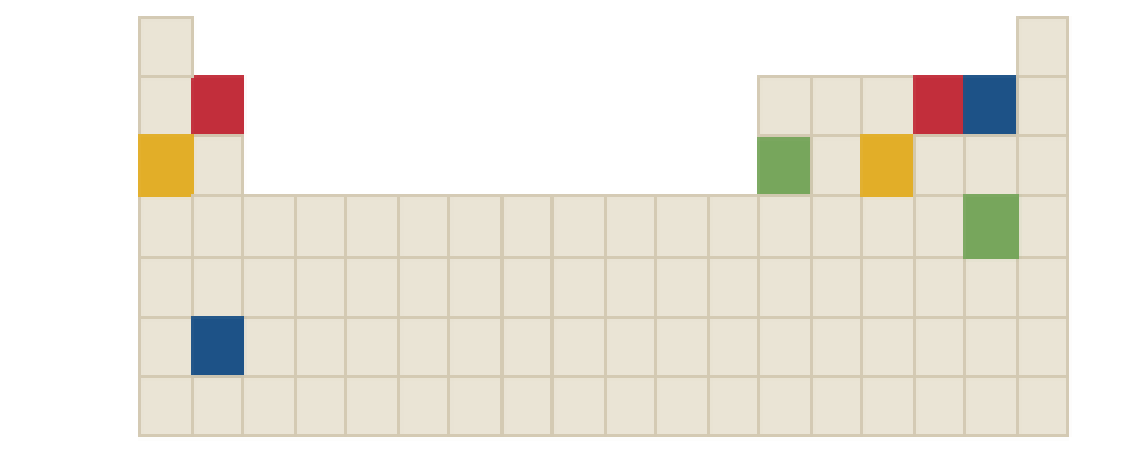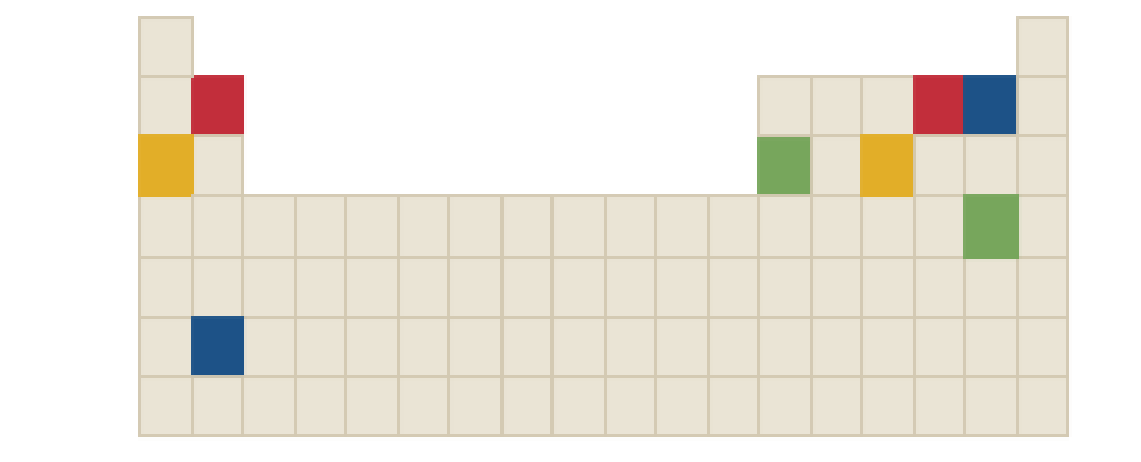
Concept explainers
(a)
Interpretation:
The chemical formula of red compound in the following periodic table is to be identified.

Concept Introduction:
Ions are formed by the loss or gain of electrons. The formation of ion requires the presence of two elements, these two elements are: one is metal atom and another one is non-metal atom. Metal atom loses electron and non-metal atom accepts electron.
The ratio in which positive and negative ions combine is the ratio which achieves charge neutrality for the resulting compound.
There three rules to remember while writing the chemical formulas. They are as follows:
- First write the symbol for positive ion.
- The charges of the ions are not shown in the formula.
- The numbers in the formula give the combining ratio for the ions.
(b)
Interpretation:
The chemical formula of blue compound in the following periodic table is to be identified.

Concept Introduction:
Ions are formed by the loss or gain of electrons. The formation of ion requires the presence of two elements, these two elements are: one is metal atom and another one is non-metal atom. Metal atom loses electron and non-metal atom accepts electron.
The ratio in which positive and negative ions combine is the ratio which achieves charge neutrality for the resulting compound.
There three rules to remember while writing the chemical formulas. They are as follows:
- First write the symbol for positive ion.
- The charges of the ions are not shown in the formula.
- The numbers in the formula give the combining ratio for the ions.
(c)
Interpretation:
The chemical formula of yellow compound in the following periodic table is to be identified.

Concept Introduction:
Ions are formed by the loss or gain of electrons. The formation of ion requires the presence of two elements, these two elements are: one is metal atom and another one is non-metal atom. Metal atom loses electron and non-metal atom accepts electron.
The ratio in which positive and negative ions combine is the ratio which achieves charge neutrality for the resulting compound.
There three rules to remember while writing the chemical formulas. They are as follows:
- First write the symbol for positive ion.
- The charges of the ions are not shown in the formula.
- The numbers in the formula give the combining ratio for the ions.
(d)
Interpretation:
The chemical formula of green compound in the following periodic table is to be identified.

Concept Introduction:
Ions are formed by the loss or gain of electrons. The formation of ion requires the presence of two elements, these two elements are: one is metal atom and another one is non-metal atom. Metal atom loses electron and non-metal atom accepts electron.
The ratio in which positive and negative ions combine is the ratio which achieves charge neutrality for the resulting compound.
There three rules to remember while writing the chemical formulas. They are as follows:
- First write the symbol for positive ion.
- The charges of the ions are not shown in the formula.
- The numbers in the formula give the combining ratio for the ions.
Want to see the full answer?
Check out a sample textbook solution
Chapter 4 Solutions
General, Organic, and Biological Chemistry
- The quantum yield of the photochemical decay of HI is 2. Calculating the moles of HI per kJ of radiant energy can be decayed knowing that the energy absorbed per mole of photons is 490 kJ.arrow_forwardThe quantum yield of the photochemical decay of HI is 2. Calculate the number of Einsteins absorbed per mole knowing that the energy absorbed per mole of photons is 490 kJ.arrow_forwardThe quantum yield of the photochemical decay of HI is 2. How many moles of HI per kJ of radiant energy can be decayed knowing that the energy absorbed per mole of photons is 490 kJ.arrow_forward
- If the energy absorbed per mole of photons is 450 kJ, the number of Einsteins absorbed per 1 mole.arrow_forwardWhen propionic aldehyde in vapor form at 200 mmHg and 30°C is irradiated with radiation of wavelength 302 nm, the quantum yield with respect to the formation of CO is 0.54. If the intensity of the incident radiation is 1.5x10-3 W, find the rate of formation of CO.arrow_forwardDraw mechanismarrow_forward
- Does Avogadro's number have units?arrow_forwardExplain why the total E in an Einstein depends on the frequency or wavelength of the light.arrow_forwardIf the dissociation energy of one mole of O2 is 5.17 eV, determine the wavelength that must be used to dissociate it with electromagnetic radiation. Indicate how many Einstein's of this radiation are needed to dissociate 1 liter of O2 at 25°C and 1 atm of pressure.Data: 1 eV = 96485 kJ mol-1; R = 0.082 atm L K-1; c = 2.998x108 m s-1; h = 6.626x10-34 J s; NA = 6.022x 1023 mol-1arrow_forward
- Indicate the number of Einsteins that are equivalent to 550 kJ mol⁻¹ of absorbed energy (wavelength 475 nm).arrow_forwardIndicate the number of einsteins that are equivalent to 550 kJ mol⁻¹ of absorbed energy?arrow_forwardA unit used in photochemistry is the einstein. If 400 kJ mol-1 of energy has been absorbed, how many einsteins is this equivalent to?arrow_forward
 Introductory Chemistry: An Active Learning Approa...ChemistryISBN:9781305079250Author:Mark S. Cracolice, Ed PetersPublisher:Cengage Learning
Introductory Chemistry: An Active Learning Approa...ChemistryISBN:9781305079250Author:Mark S. Cracolice, Ed PetersPublisher:Cengage Learning Chemistry for Today: General, Organic, and Bioche...ChemistryISBN:9781305960060Author:Spencer L. Seager, Michael R. Slabaugh, Maren S. HansenPublisher:Cengage LearningChemistry: Matter and ChangeChemistryISBN:9780078746376Author:Dinah Zike, Laurel Dingrando, Nicholas Hainen, Cheryl WistromPublisher:Glencoe/McGraw-Hill School Pub Co
Chemistry for Today: General, Organic, and Bioche...ChemistryISBN:9781305960060Author:Spencer L. Seager, Michael R. Slabaugh, Maren S. HansenPublisher:Cengage LearningChemistry: Matter and ChangeChemistryISBN:9780078746376Author:Dinah Zike, Laurel Dingrando, Nicholas Hainen, Cheryl WistromPublisher:Glencoe/McGraw-Hill School Pub Co World of Chemistry, 3rd editionChemistryISBN:9781133109655Author:Steven S. Zumdahl, Susan L. Zumdahl, Donald J. DeCostePublisher:Brooks / Cole / Cengage Learning
World of Chemistry, 3rd editionChemistryISBN:9781133109655Author:Steven S. Zumdahl, Susan L. Zumdahl, Donald J. DeCostePublisher:Brooks / Cole / Cengage Learning Introductory Chemistry: A FoundationChemistryISBN:9781337399425Author:Steven S. Zumdahl, Donald J. DeCostePublisher:Cengage Learning
Introductory Chemistry: A FoundationChemistryISBN:9781337399425Author:Steven S. Zumdahl, Donald J. DeCostePublisher:Cengage Learning





